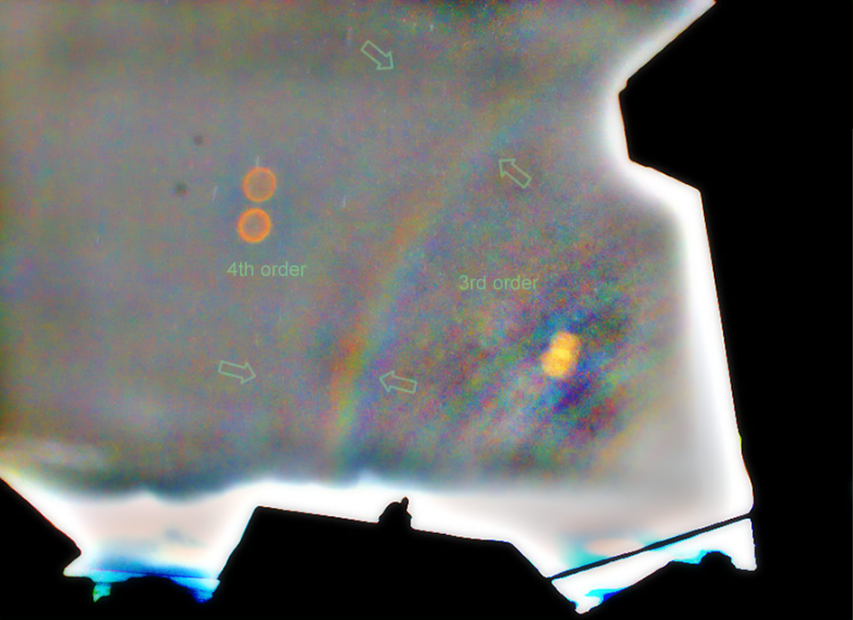3rd & 4th order rainbows - OPOD
Exploring the Enigmatic 3rd & 4th Order Rainbows
Rainbows have long captivated our imagination with their ethereal beauty and colorful displays. Most of us are familiar with the primary and secondary rainbows, but did you know that there are even more elusive and mysterious rainbows known as 3rd and 4th order rainbows? These rare atmospheric phenomena have recently been observed and photographed by keen-eyed observers, shedding new light on the intricacies of light scattering in the atmosphere.
The discovery of a possible 3rd order rainbow was first featured in an OPOD (Optics Picture of the Day) by Alec Jones, aptly named the "Bolton Halo Triangle." This observation sparked curiosity and led to further investigation, eventually confirming the existence of not only a 3rd order rainbow but also a 4th order rainbow. The confirmation came through image processing techniques applied by Nicolas Lefaudeux from opticsaround.
The 3rd order rainbow, depicted in the processed images, forms a broad circle around the sun, which is located just outside the frame at the bottom right. Although it shares a similar size to the ordinary primary rainbow, it is fainter and concealed amidst the zero-order glow and other scattered light. Its presence adds another layer of enchantment to the atmospheric optics phenomenon.
Contrary to the inner 3rd order rainbow, the outer 4th order rainbow exhibits a reverse color pattern and is even broader and fainter. This discovery was first made by Michael Theusner in 2011, a mere month after Michael Großmann's pioneering photograph of the elusive 3rd order rainbow. The combined efforts of these dedicated observers have expanded our understanding of rainbows beyond the conventional primary and secondary ones.
The images captured by Alec Jones, with permission, offer captivating glimpses into these higher-order rainbows. However, it is worth noting that the processing of these images played a crucial role in revealing the intricate details. Nicolas Lefaudeux employed various techniques to enhance the images, such as stacking multiple images, adjusting colors, reducing noise, and removing unwanted elements like raindrops. These meticulous steps helped bring out the subtleties of the 3rd and 4th order rainbows.
While these higher-order rainbows may seem elusive and rare, they are actually a result of the same optical principles that govern the formation of primary and secondary rainbows. The primary rainbow occurs when sunlight is refracted, reflected, and internally reflected within raindrops, resulting in the separation of colors. Similarly, higher-order rainbows form when light undergoes multiple internal reflections within raindrops, leading to further color separation and the appearance of additional concentric rings.
The discovery and documentation of 3rd and 4th order rainbows serve as a reminder of the complexity and beauty of nature's optical phenomena. They inspire us to continue exploring the mysteries of our atmosphere and uncovering hidden wonders that lie just beyond our everyday perception.
In conclusion, the existence of 3rd and 4th order rainbows has been confirmed through meticulous observations and image processing techniques. These rare atmospheric phenomena offer a deeper understanding of light scattering in the atmosphere and add another layer of enchantment to the world of atmospheric optics. The captivating images captured by Alec Jones and processed by Nicolas Lefaudeux provide a glimpse into the elusive beauty of these higher-order rainbows. As we delve further into the complexities of our atmosphere, we continue to unravel the mysteries that surround us, revealing the awe-inspiring wonders that nature has in store.

Sequel..
3rd & 4th Order Rainbows
A recent OPOD featured Alec Jones (Bolton Halo Triangle) observation of a possible 3rd order rainbow. Here it is confirmed.. ..plus a 4th order.
Left: Extra image processing by Nicolas Lefaudeux (opticsaround). He stacked the two images of Alec Jones and then used an RGB - grey subtraction technique.
The broad 3rd order bow circles the sun which is off image at bottom right. It is roughly the same size as the ordinary primary rainbow but is fainter and hidden deep in zero order glow and other scattered light.
Outside it is the reverse colour and even broader and fainter fourth order rainbow.
The 4th order bow was first imaged by Michael Theusner in 2011 just one month after Michael Gro�mann's first photograph ever of the elusive 3rd order.
All images ©Alec Jones, shown with permission





Image processing by Nicolas Lefaudeux:
Full details written by Nicolas here
Grey scale image
black adjustment
white adjustment
4x4 digital binning to reduce noise and increase dynamic range
background generation and subtraction
median to remove rain drops
stacking of the two images
reduction of highest spatial frequencies (~small radius blur)
final adjustments (curves, etc...)
Top image
RGB minus grey to remove residual intensity variations and enhance colour variations and combined it with grey scale image to get a good looking picture.
Note: this article has been automatically converted from the old site and may not appear as intended. You can find the original article here.
Reference Atmospheric Optics
If you use any of the definitions, information, or data presented on Atmospheric Optics, please copy the link or reference below to properly credit us as the reference source. Thank you!
-
<a href="https://atoptics.co.uk/blog/3rd-4th-order-rainbows-opod/">3rd & 4th order rainbows - OPOD</a>
-
"3rd & 4th order rainbows - OPOD". Atmospheric Optics. Accessed on November 25, 2024. https://atoptics.co.uk/blog/3rd-4th-order-rainbows-opod/.
-
"3rd & 4th order rainbows - OPOD". Atmospheric Optics, https://atoptics.co.uk/blog/3rd-4th-order-rainbows-opod/. Accessed 25 November, 2024
-
3rd & 4th order rainbows - OPOD. Atmospheric Optics. Retrieved from https://atoptics.co.uk/blog/3rd-4th-order-rainbows-opod/.